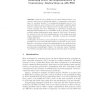205 search results - page 6 / 41 » Relaxed memory models: an operational approach |
ALIFE
1999
13 years 7 months ago
1999
A novel machine language genetic programming system that uses one-dimensional core memories is proposed and simulated. The core is compared to a biochemical reaction space, and in ...
ECOOP
2010
Springer
14 years 14 days ago
2010
Springer
ncy Abstractions on x86-TSO Scott Owens University of Cambridge Abstract. With the rise of multi-core processors, shared-memory concurrency has become a widespread feature of compu...
CVPR
2004
IEEE
14 years 9 months ago
2004
IEEE
This paper explores a formulation for attributed graph matching as an inference problem over a hidden Markov Random Field. We approximate the fully connected model with simpler mo...
ASPLOS
1996
ACM
13 years 11 months ago
1996
ACM
This paper describes Shasta, a system that supports a shared address space in software on clusters of computers with physically distributed memory. A unique aspect of Shasta compa...
TPHOL
2009
IEEE
14 years 2 months ago
2009
IEEE
Abstract. Real multiprocessors do not provide the sequentially consistent memory that is assumed by most work on semantics and verification. Instead, they have relaxed memory mode...


